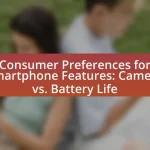Trade-in programs are initiatives by smartphone manufacturers and retailers that allow consumers to exchange old devices for credit towards new smartphone purchases. These programs significantly influence consumer choices by lowering the effective cost of new devices, fostering brand loyalty, and shaping market dynamics. Key components include device evaluation, trade-in value determination, and eligibility guidelines, which enhance consumer engagement. The article explores how trade-in programs affect affordability, brand loyalty, and consumer behavior, while also addressing challenges, misconceptions, and demographic factors influencing participation. Additionally, it examines the competitive landscape and future implications of these programs in the smartphone market.

What are Trade-In Programs and How Do They Influence Consumer Choices in Smartphone Brands?
Trade-in programs are initiatives offered by smartphone manufacturers and retailers that allow consumers to exchange their old devices for credit towards the purchase of new smartphones. These programs significantly influence consumer choices by reducing the effective cost of new devices, making them more financially accessible. For instance, a study by Deloitte in 2021 indicated that 30% of consumers reported that trade-in offers were a key factor in their decision to upgrade to a new smartphone. This financial incentive encourages brand loyalty and can sway consumers towards specific brands that offer more favorable trade-in values, thereby shaping market dynamics and consumer preferences in the smartphone industry.
How do Trade-In Programs function in the smartphone market?
Trade-in programs in the smartphone market allow consumers to exchange their old devices for credit towards the purchase of new smartphones. These programs typically assess the condition and model of the traded-in device to determine its value, which is then applied as a discount on the new purchase. For instance, companies like Apple and Samsung have established trade-in programs that incentivize customers to upgrade by offering competitive trade-in values, thus influencing consumer choices and brand loyalty. According to a 2022 report by Counterpoint Research, approximately 30% of smartphone buyers utilized trade-in programs, highlighting their significant role in consumer decision-making and brand preference.
What are the key components of a Trade-In Program?
The key components of a Trade-In Program include the evaluation of the device’s condition, the determination of its trade-in value, the process for exchanging the old device for credit or discounts, and the guidelines for eligibility. Evaluation involves assessing the physical and functional state of the device, which directly influences its trade-in value. The trade-in value is typically calculated based on market demand and the device’s age and condition, providing consumers with a monetary incentive to participate. The exchange process allows consumers to apply the trade-in value towards the purchase of a new device, often resulting in significant savings. Eligibility guidelines ensure that only certain devices or conditions qualify for trade-in, which helps maintain the program’s integrity and profitability. These components collectively enhance consumer engagement and influence purchasing decisions in the smartphone market.
How do consumers typically engage with Trade-In Programs?
Consumers typically engage with Trade-In Programs by exchanging their old devices for credit towards new purchases. This process often involves assessing the condition of the old device, receiving a valuation, and applying that value as a discount on a new smartphone. According to a 2022 survey by Consumer Technology Association, 40% of smartphone users reported utilizing trade-in programs to offset the cost of new devices, indicating a significant trend in consumer behavior towards maximizing value through these programs.
What are the advantages of Trade-In Programs for consumers?
Trade-In Programs offer consumers several advantages, primarily financial savings and convenience. By allowing consumers to exchange their old devices for credit towards new purchases, these programs reduce the overall cost of acquiring new smartphones. For instance, a study by Deloitte found that 40% of consumers are more likely to upgrade their devices when a trade-in option is available, highlighting the financial incentive. Additionally, Trade-In Programs simplify the upgrade process, as consumers can easily dispose of their old devices while receiving immediate value, thus enhancing the overall shopping experience.
How do Trade-In Programs affect the affordability of new smartphones?
Trade-in programs significantly enhance the affordability of new smartphones by providing consumers with a monetary credit for their old devices. This credit reduces the overall purchase price of a new smartphone, making it more accessible. For instance, a study by Counterpoint Research indicated that trade-in programs can lower the effective price of a new smartphone by up to 30%, depending on the model and condition of the traded device. This financial incentive encourages consumers to upgrade more frequently, thereby influencing their choices in smartphone brands and models.
What role do Trade-In Programs play in brand loyalty?
Trade-In Programs significantly enhance brand loyalty by providing consumers with tangible incentives to remain with a brand. These programs allow customers to exchange their old devices for credit towards new purchases, effectively lowering the cost of upgrading and creating a sense of value. Research indicates that 60% of consumers are more likely to stay loyal to a brand that offers a trade-in option, as it fosters a continuous relationship and encourages repeat purchases. This loyalty is further reinforced by the convenience and financial benefits associated with trade-ins, making consumers feel appreciated and understood by the brand.
What challenges do consumers face when using Trade-In Programs?
Consumers face several challenges when using Trade-In Programs, primarily related to valuation discrepancies and limited options. Valuation discrepancies occur when the trade-in value offered for a device is significantly lower than its market value, leading to consumer dissatisfaction. For instance, a study by Consumer Reports found that trade-in values can be up to 30% less than what consumers could receive through private sales. Additionally, limited options in trade-in programs can restrict consumers to specific brands or models, reducing their flexibility in choosing new devices. This lack of variety can hinder consumers from making optimal choices that align with their preferences and needs.
What are common misconceptions about Trade-In Programs?
Common misconceptions about trade-in programs include the belief that they always provide the highest value for old devices and that the process is overly complicated. Many consumers assume that trade-in values are consistently better than selling devices independently, but studies show that third-party resale often yields higher returns. Additionally, some individuals think that trade-in programs involve lengthy procedures, while most companies have streamlined processes that allow for quick evaluations and transactions. These misconceptions can lead consumers to undervalue their options and miss out on potentially better financial outcomes.
How do Trade-In values vary between different smartphone brands?
Trade-in values significantly vary between different smartphone brands, influenced by factors such as brand reputation, demand, and device condition. For instance, Apple devices typically command higher trade-in values due to strong brand loyalty and consistent demand, with trade-in values often exceeding $300 for recent models. In contrast, Android brands like Samsung and Google may offer lower trade-in values, averaging around $200 for comparable models, reflecting varying consumer perceptions and market demand. This disparity is supported by data from trade-in platforms, which consistently show that flagship models from premium brands retain value better than those from mid-range or lesser-known brands.

How do Trade-In Programs impact consumer behavior in the smartphone market?
Trade-in programs significantly influence consumer behavior in the smartphone market by incentivizing upgrades and reducing the overall cost of new devices. These programs encourage consumers to exchange their old smartphones for credit towards new purchases, making the transition to newer models more financially feasible. According to a 2021 study by Counterpoint Research, 40% of consumers reported that trade-in offers were a key factor in their decision to upgrade, highlighting the effectiveness of these programs in driving sales. Additionally, trade-in programs create a sense of value retention for consumers, as they perceive their old devices as having monetary worth, which further motivates them to engage in the upgrade cycle.
What trends have emerged in consumer choices due to Trade-In Programs?
Trade-In Programs have led to increased consumer preference for upgrading to newer smartphone models while reducing overall costs. This trend is evidenced by a significant rise in consumers opting for trade-ins, with reports indicating that approximately 30% of smartphone buyers utilized trade-in options in 2022, reflecting a shift towards more sustainable purchasing behaviors. Additionally, consumers are increasingly loyal to brands that offer attractive trade-in incentives, influencing their choices and fostering brand loyalty.
How do Trade-In Programs influence brand switching among consumers?
Trade-in programs significantly influence brand switching among consumers by providing financial incentives that lower the cost of acquiring new devices. These programs allow consumers to exchange their old smartphones for credit towards a new purchase, making it more affordable to switch brands. For instance, a study by Deloitte in 2021 found that 40% of consumers who participated in trade-in programs reported being more likely to switch brands due to the perceived value of the trade-in offer. This financial motivation can lead consumers to explore alternatives they may not have considered otherwise, ultimately driving brand loyalty shifts in the competitive smartphone market.
What demographic factors affect consumer participation in Trade-In Programs?
Demographic factors that affect consumer participation in Trade-In Programs include age, income level, education, and geographic location. Younger consumers, particularly those aged 18-34, are more likely to engage in trade-in programs due to their familiarity with technology and desire for the latest devices. Higher income levels correlate with increased participation, as consumers with more disposable income are more inclined to upgrade their devices frequently. Education also plays a role; individuals with higher education levels tend to be more aware of the benefits of trade-in programs. Geographic location influences participation as well, with urban consumers often having greater access to trade-in options and promotional offers compared to those in rural areas. These factors collectively shape consumer behavior in the context of trade-in programs, as evidenced by market research indicating that younger, urban, and higher-income demographics are more likely to utilize such programs.
How do Trade-In Programs affect the competitive landscape of smartphone brands?
Trade-in programs significantly enhance the competitive landscape of smartphone brands by incentivizing consumer loyalty and driving sales. These programs allow consumers to exchange their old devices for credit towards new purchases, effectively lowering the cost barrier for upgrading. For instance, Apple’s trade-in program reported that 35% of customers who traded in their devices purchased a new iPhone, demonstrating how such initiatives can directly influence consumer behavior and brand preference. Additionally, brands that offer attractive trade-in values can differentiate themselves in a saturated market, compelling competitors to enhance their own trade-in offerings to retain market share. This competitive dynamic fosters innovation and pricing strategies among smartphone manufacturers, ultimately benefiting consumers through better deals and improved product features.
What strategies do smartphone brands employ to enhance their Trade-In Programs?
Smartphone brands enhance their Trade-In Programs through strategies such as offering competitive trade-in values, simplifying the process, and providing instant credit towards new purchases. By offering competitive trade-in values, brands like Apple and Samsung attract consumers by ensuring that the value of their old devices is maximized, which can significantly influence purchasing decisions. Simplifying the trade-in process, such as through online assessments and easy shipping options, reduces friction for consumers, making it more likely they will participate. Additionally, providing instant credit allows consumers to immediately apply the trade-in value to their new purchase, creating a seamless transition that encourages upgrades. These strategies collectively increase consumer engagement and loyalty, ultimately impacting their choices in smartphone brands.
How do Trade-In Programs impact the pricing strategies of smartphone manufacturers?
Trade-in programs significantly influence the pricing strategies of smartphone manufacturers by allowing them to offer competitive pricing and incentivize upgrades. These programs enable manufacturers to reduce the effective price consumers pay for new devices by providing credit for old smartphones, which can lead to increased sales and customer retention. For instance, Apple reported that trade-in programs contributed to a 20% increase in iPhone sales during promotional periods, demonstrating how such initiatives can effectively lower the perceived cost of new models and encourage consumer purchases.

What are the future implications of Trade-In Programs on smartphone consumer choices?
Trade-In Programs will increasingly influence smartphone consumer choices by making upgrades more financially accessible. As consumers become more aware of the value of their old devices, they are likely to opt for brands that offer competitive trade-in values, thereby fostering brand loyalty and encouraging frequent upgrades. According to a 2022 survey by Deloitte, 60% of consumers indicated that trade-in offers significantly impacted their decision to purchase a new smartphone, highlighting the growing importance of these programs in shaping consumer behavior.
How might technological advancements influence Trade-In Programs?
Technological advancements significantly enhance Trade-In Programs by improving valuation accuracy and streamlining the process for consumers. Innovations such as artificial intelligence and machine learning enable companies to assess the condition and market value of devices more precisely, resulting in fairer trade-in offers. For instance, companies like Apple and Samsung utilize advanced algorithms to evaluate devices based on real-time market data, which can lead to increased consumer trust and participation in these programs. Additionally, mobile applications and online platforms facilitate seamless trade-in transactions, allowing consumers to quickly receive quotes and complete trades from their devices, thereby increasing the overall efficiency of the trade-in process.
What role will sustainability play in the evolution of Trade-In Programs?
Sustainability will play a crucial role in the evolution of Trade-In Programs by driving consumer demand for environmentally responsible practices. As awareness of environmental issues increases, consumers are more likely to participate in Trade-In Programs that promote recycling and reduce electronic waste. For instance, a study by the Global E-Waste Monitor reported that in 2019, 53.6 million metric tons of e-waste were generated globally, highlighting the need for effective recycling solutions. Companies that integrate sustainability into their Trade-In Programs can enhance brand loyalty and attract eco-conscious consumers, ultimately influencing their purchasing decisions in favor of brands that prioritize environmental responsibility.
How can smartphone brands innovate their Trade-In Programs to attract more consumers?
Smartphone brands can innovate their Trade-In Programs by offering instant credit, flexible upgrade options, and enhanced user experiences. Instant credit allows consumers to receive immediate discounts on new purchases, making the trade-in process seamless and appealing. Flexible upgrade options enable consumers to trade in their devices at any time, rather than being locked into specific timelines, which increases consumer satisfaction and engagement. Enhanced user experiences, such as user-friendly online platforms for evaluating trade-in values and personalized recommendations, can further attract consumers. According to a 2022 survey by Deloitte, 60% of consumers indicated that a straightforward trade-in process significantly influences their purchasing decisions, highlighting the importance of these innovations in driving consumer choices.
What best practices should consumers consider when participating in Trade-In Programs?
Consumers should research the trade-in value of their device before participating in Trade-In Programs. This involves comparing offers from multiple retailers and platforms to ensure they receive the best possible value for their device. According to a 2022 survey by Consumer Reports, consumers who compared trade-in values across different services often found discrepancies of up to 30%, highlighting the importance of thorough research. Additionally, consumers should ensure their device is in good condition, as many programs have specific criteria that can affect the final trade-in value. Cleaning the device and addressing minor repairs can enhance its value. Finally, consumers should read the terms and conditions of the trade-in program carefully to understand any potential fees or limitations, as these can impact the overall benefit of the trade-in.
How can consumers maximize the value of their trade-ins?
Consumers can maximize the value of their trade-ins by ensuring their devices are in optimal condition and researching trade-in values beforehand. Maintaining devices in good working order, including cleaning them and fixing minor issues, can significantly enhance their resale value. According to a study by Consumer Reports, devices that are well-maintained can fetch up to 30% more in trade-in value compared to those with visible wear and tear. Additionally, consumers should compare trade-in offers from multiple retailers and platforms to identify the best deal, as prices can vary widely. By taking these steps, consumers can effectively increase the financial return on their trade-ins.
What should consumers look for in a Trade-In Program to ensure a positive experience?
Consumers should look for transparency in valuation and terms when evaluating a Trade-In Program to ensure a positive experience. A clear explanation of how the trade-in value is determined, including factors like device condition and market demand, helps consumers feel confident in the process. Additionally, programs that offer competitive trade-in values compared to market standards enhance consumer satisfaction. According to a 2022 survey by Consumer Reports, 78% of participants indicated that understanding the trade-in value significantly influenced their decision to participate in such programs. Furthermore, a straightforward and user-friendly process, including easy online assessments and prompt payment, contributes to a seamless experience.




